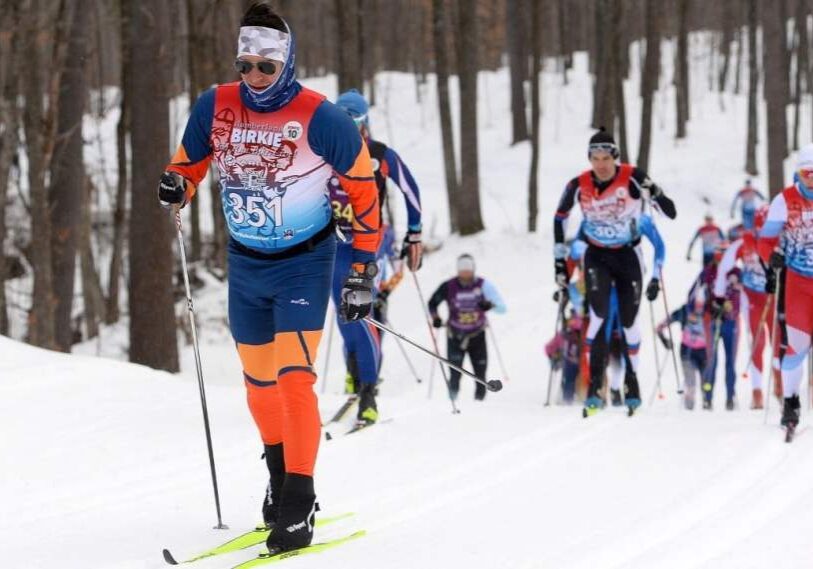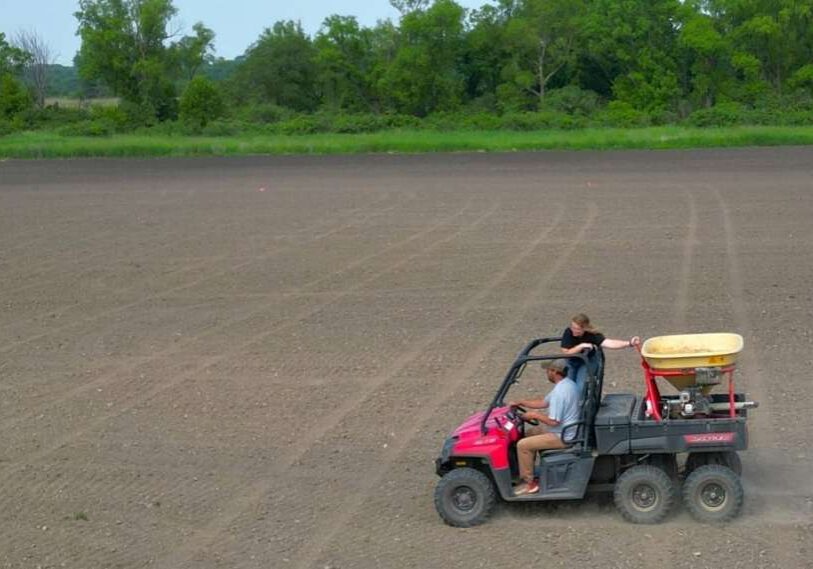Conservation Ballot Initiative Key to Trust Fund Renewal

CHOICE — A long-necked excavator roared dirt off the banks of Vesta Creek south of Rushford and smoothed down the soil, rattling the usually peaceful wooded valley flanking the tiny creek. Nearby, a large dump truck moved dirt to the side. Next year, shrubs designed to tolerate more heat expected from climate change will be planted on Vesta’s banks.
That is how Chris Lenhart designed the work and what he will be studying for a few years to see how well Vesta and the shrubs respond.
Above the valley, on a former goat prairie and a nearby flat prairie, goats chomped on unwanted buckthorn and prickly ash, a rare red-headed woodpecker swooshed, bees took nectar from goldenrod and a large gangly praying mantis perched on a plant dying in the early fall day.
That is what Ellen Titus hoped to be seeing as she studies how well goats and other forms of prairie restoration work.
Paying for the excavation work was money from the state’s Legacy Amendment that voters approved in 2008 to add a little to the state’s sales tax to pay for fish and wildlife enhancements, parks and trails as well as historical and cultural programs. Paying for the studies by Lenhart and Titus is the state’s “Environment and Natural Resources Trust Fund.” Previously funded through 2025, 77% of Minnesota voters approved a November 5th general election ballot to renew funding through 2050. [Updates from the Minnesota Secretary of State’s Office, November 2024.]

Minnesota’s Environment and Natural Resources Trust Fund is on the November 5 ballot for renewal. (Photo by John Weiss)
“The Legacy Funds and lottery dollars work well together at the Choice Wildlife Management Area (WMA),” said Chris Anderson, senior media relations manager, Great Plains Division of The Nature Conservancy. Choice projects are typical of so much more work being done in the southeast, he said.
Anderson explained that the southeast corner of Minnesota is incredibly rich in biodiversity because of its bluffs unique to Minnesota, as well as the prairies, trout streams, stream bottoms and Mississippi River.
The need for the trust fund renewal convinced about 125 groups to join Minnesotans for Our Great Outdoors to promote a yes vote this fall. (If you vote but skip the trust fund question, it will count as a NO vote.) Some groups in the coalition are obvious, such as The Nature Conservancy and Trout Unlimited but, interestingly, some of the groups aren’t ones you’d normally consider environmental or natural resource backers such as the Coalition of Greater Minnesota Cities and Fairmont Economic Development Authority.
Choice is part of the Southeast Minnesota Protection and Restoration Project that began 11 years ago and gets money year after year to do more in the region. Legacy money paid about $150,000 to shape back Vesta’s banks and plant the shrubs, and another $243,000 of trust fund dollars paid for the research. $483,000 Trust Fund money will pay for bluff prairie and flat prairie monitoring in the valley.
Legacy money has paid for many more additions to state lands, such as the new Moon Valley Wildlife Management Area northwest of Rochester, additions to McCarthy Lakes WMA south of Kellogg, and the Richard J. Dorer Memorial Hardwood Forest spread across the region.
But here’s where trust fund money is so critical — in many cases, no one knows for sure what’s the best way to preserve and restore trout streams, bluff prairies, and other resources.
“Different groups have worked on bluff prairies for years but there’s no research on how to do it well,” Anderson said. “We know grazing is a piece, fire is a piece, and herbicides are a piece. But how do you do that all well? Which do you do first? All those questions are the ones (managers) need answers to.”
The next piece of the work is finding ways that work now and well into the future. “We have this holistic program that is looking at sites that need to be protected,” Anderson said.
He predicted trust fund money and the research will teach them lessons they can apply to other sites. “It’s going to make a huge difference,” he said. “It has not been done in this region before. We think it has a lot of promise.”
Vesta Creek research plan
Lenhart is a research professor in the University of Minnesota’s Department of Bioproducts and Biosystems Engineering and also works with restoration with The Nature Conservancy. Vesta “is cool because I was involved in the design and I get to do the research on it.” The plan calls for reshaping about 350 feet of the trout stream and stabilizing about 150 feet of a gully leading into it.

Work is underway to restore Vesta Creek near Choice after years of flooding and silt build up. (Photo by John Weiss)
Vesta is typical of just about every cold-water trout stream, and cool water rivers, in this region, he said. Once pristine, poor land-use practices allowed millions of tons of topsoil to erode down their valleys, raising the banks. Water cut down the banks, but with the tall banks floodwaters often can’t get out and cause erosion. Vesta has banks about 8 feet tall, while the stream is maybe 10 feet wide.
“Overall, it’s a pretty healthy stream because it has brook trout that need the purest water, but it’s entrenched and can’t naturally meander,” Lenhart said.
Lenhart explained that the southeast is adding more rainfall on average than the rest of the state, so it’s expected to get more heavy rains, and streams will have to tolerate more floods.
That’s where that excavator entered the picture in September. It sloped back the banks quite a bit from the stream so rising waters can spread out.
Lenhart said the plan will have study sites in the Root River watershed: control, adaptation approach (Vesta Creek), traditional restoration approach (Maple Creek). The control site will not have shrub plantings or any excavation done. The traditional approach will involve placement of instream and bank practices but not adaptation or excavation practices. The adaptation approach will include both excavation and planting of riparian shrubs.
“The creek will be able to get the flood plain in there and the stream will be able to re-meander…it’s not very sinuous at all,” Lenhart said.
Here’s a critical part: if the project works as he designed it, Vesta will be able to naturally meander and keep changing a bit each year instead of being confined by rocks.
“The benefits will last for decades or more,” he said. “It’s the best kind of restoration.”
Next year, shrubs will be planted along Vesta. Instead of plants from around here, they will be from northeast Iowa because climate change is making weather around here a bit more like Iowa. The plants will help stabilize the banks, provide some wildlife benefits and, it is hoped, outcompete reed canary grass, a relatively tall grass that bulls its way into open land along streams and takes over.
Again, this is an experiment, Lenhart said. “There is a lot less known about them,” he said.

A goat munches on vegetation at the Vesta Creek Bluff Management area. Goats are one way of controlling invasive plants. (Photo by John Weiss)
Vesta Creek bluff management
Talking with Ellen Titus about work she’s monitoring atop the bluff overlooking Vesta Creek was fascinating, illuminating and rather disjointed. The adaptive management research specialist with The Nature Conservancy was explaining what she’s doing to see how well different prairie management techniques work when, swoosh, a mature redheaded woodpecker landed in a tree. Or a monarch butterfly flitted past.

An immature red-headed woodpecker inspects a dead tree limb for food at the Vesta Creek Bluff Management area. (Photo by John Weiss)
Explanations can wait when there is a bird or butterfly that is facing hard times lands on a dead tree atop the goat prairie. They are a priority and she oohed and aahhed, admiring them. Then it was back to her explanation finding ways to improve goat prairies so there will be more red-headed woodpeckers, indigo buntings, skipper butterflies, all kinds of flowers and grassed, butterflies, skinks, even rattlesnakes.
Though you might not be able to imagine it now, much of the region’s south- and west-facing bluffsides were once goat prairie, so named because it takes the footing of a goat to be able to easily walk on them. Trees and shrubs were kept at bay with fires either lit by Native Americans or occurred naturally with lightning.
Along came Europeans who stopped the fires, began grazing cattle and generally allowed trees to take over most of them. But not all. A few remain either naturally or have been managed or restored. Fire is one of the main weapons in the battle against woody invasives, but is it the best?
That is what Titus is trying to figure out. She’s monitoring not only overgrown goat prairie overlooking Vesta but also the flat prairie nearby.
“I work as part of the science team to really look at what’s going on with these bluffs,” she said. “We have a grant to see how management is affecting the biological communities. The prairie has trees on the upper part, and the oaks are allowed to remain, but it’s more open farther down the hill.
Titus explained that the goal is to get resilient prairies maintained with a little bit of natural burn every few years. If it has more diversity of plants, it will also be able to tolerate dry years and wet years.

A bee nestles up to a prairie plant. Prairies are a vital lifeblood for insects and wildlife. (Photo by John Weiss)
“We have a lot of animals that need and use that prairie down there,” she said about the Vesta bluff. “There are animals that need and use these habitats. These habitats have shrunk, we are seeing less and less of them.”
And in a nifty twist, it’s goats — a big herd of live goats — that are helping restore goat prairie. “That’s why the goats are here, they love to eat buckthorn. They take care of it without chemicals,” she said.
Once they turn a section brown — yes, she loves seeing a bluff side showing mostly brown — goats are moved to another paddock, three in all, kept in by an electric fence. Goats will be brought back a few times because the trees will regrow leaves, Titus said. But after getting leaves chomped off several times, woody vegetation dies.
The portion Titus is monitoring is from 40 to 45 acres. Some private prairie owners have used chemicals to kill off the unwanted woody vegetation but The Nature Conservancy is trying to find what system or combination of restoration techniques works best in the short run as well as for many years to come.
One might wonder why money is being spent on the endangered prairies when not a lot of people understand or use them.
“It’s important to keep the state’s natural heritage too. This is also just a part of what Minnesota has to offer,” she said.
Editor’s note: Root River Current is neither an advocate for or against Minnesota’s Legacy Amendment. It is, however, supportive of helping the public understand how Legacy funding is put to work in the greater Root River Valley region; and, in full transparency, Root River Current receives Legacy support through Minnesota’s Arts & Cultural Heritage Fund for its coverage of the arts.






